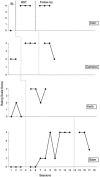Evaluation of behavioral skills training for teaching abduction-prevention skills to young children
- PMID: 15898475
- PMCID: PMC1224410
- DOI: 10.1901/jaba.2005.26-04
Evaluation of behavioral skills training for teaching abduction-prevention skills to young children
Abstract
This study examined the effectiveness of individual behavioral skills training in conjunction with in situ training in teaching 13 preschool children abduction prevention skills. Children's performance was measured during baseline, training, and at 2-week, 1-month, and 3-month follow-ups using in situ assessments in which abduction prevention skills were measured in naturalistic settings. Results revealed that all the children learned the skills and all the children available at the 2-week and 1-month follow-ups maintained the skills at criterion level. All but 3 children's criterion-level performances were maintained at the 3-month follow-up as well.
Figures



Similar articles
-
Evaluation of a commercially available program and in situ training by parents to teach abduction-prevention skills to children.J Appl Behav Anal. 2009 Winter;42(4):761-72. doi: 10.1901/jaba.2009.42-761. J Appl Behav Anal. 2009. PMID: 20514182 Free PMC article.
-
Efficacy of the stranger safety abduction-prevention program and parent-conducted in situ training.J Appl Behav Anal. 2013 Dec;46(4):817-20. doi: 10.1002/jaba.80. Epub 2013 Sep 17. J Appl Behav Anal. 2013. PMID: 24114614 Clinical Trial.
-
The use of behavioral skills training and in situ feedback to protect children with autism from abduction lures.J Appl Behav Anal. 2014 Winter;47(4):856-60. doi: 10.1002/jaba.173. Epub 2014 Oct 13. J Appl Behav Anal. 2014. PMID: 25311885
-
Pediatric Prevention: Teaching Safety Skills.Pediatr Clin North Am. 2020 Jun;67(3):573-584. doi: 10.1016/j.pcl.2020.02.011. Pediatr Clin North Am. 2020. PMID: 32443995 Review.
-
Social skills interventions for children.Behav Modif. 1993 Jul;17(3):287-313. doi: 10.1177/01454455930173004. Behav Modif. 1993. PMID: 8343100 Review.
Cited by
-
A Behavioral Safety Model for Clinical Settings: Coaching for Institutionalization.Perspect Behav Sci. 2019 Mar 26;42(4):973-985. doi: 10.1007/s40614-019-00195-1. eCollection 2019 Dec. Perspect Behav Sci. 2019. PMID: 31976470 Free PMC article.
-
Behavioral Skills Training in Portuguese Children With School Failure Problems.Front Psychol. 2018 May 29;9:437. doi: 10.3389/fpsyg.2018.00437. eCollection 2018. Front Psychol. 2018. PMID: 29896134 Free PMC article.
-
A preliminary evaluation of two behavioral skills training procedures for teaching abduction-prevention skills to schoolchildren.J Appl Behav Anal. 2006 Spring;39(1):25-34. doi: 10.1901/jaba.2006.167-04. J Appl Behav Anal. 2006. PMID: 16602383 Free PMC article.
-
Evaluating Professional Behavior Analysts' Literature Searches.Behav Anal Pract. 2022 Jun 3;16(1):284-295. doi: 10.1007/s40617-022-00720-w. eCollection 2023 Mar. Behav Anal Pract. 2022. PMID: 35677017 Free PMC article.
-
Consideration of Both Discriminated and Generalized Responding When Teaching Children with Autism Abduction Prevention Skills.Behav Anal Pract. 2021 Apr 6;14(2):396-409. doi: 10.1007/s40617-020-00541-9. eCollection 2021 Jun. Behav Anal Pract. 2021. PMID: 34150455 Free PMC article.
References
-
- Carroll-Rowan L, Miltenberger R.G. A comparison of procedures for teaching abduction prevention to preschoolers. Education and Treatment of Children. 1994;17:113–129.
-
- Finkelhor D, Hammer H, Sedlak A.J. Nonfamily abducted children: National estimates and characteristics. 2002. [Retrieved May 28, 2002]. from http:ojjdp.ncjrs.org.
-
- Gatheridge B.J, Miltenberger R, Huneke D.G, Satterlund M.J, Mattern A.R, Johnson B.M, et al. A comparison of two programs to teach firearm injury prevention skills to 6 and 7 year old children. Pediatrics. 2004;114:e294–e299. - PubMed
-
- Holcombe A, Wolery M, Katzenmeyer J. Teaching preschoolers to avoid abduction by strangers: Evaluation of maintenance strategies. Journal of Child and Family Studies. 1995;4(2):177–191.
Publication types
MeSH terms
LinkOut - more resources
Full Text Sources

